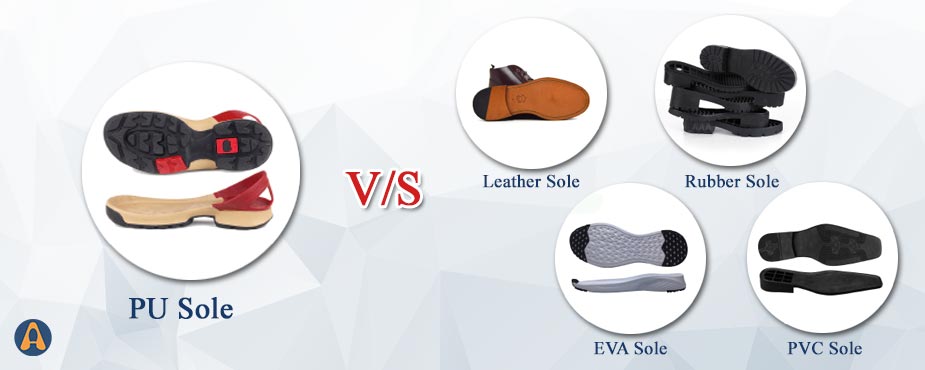Over the years, the footwear industry has experimented with various materials to quest for the best sole material for shoes, sneakers and sandals. While a lot of these materials exhibited exceptional results in specific criteria, there was one material that stood out of the crowd when it comes to holistic performance - Polyurethane (PU).
Ever since its advent, the polyurethane has been gaining popularity amidst the footwear industry and has embarked upon a journey to become the best sole material in history. What has made polyurethane so famous is its extensive set of qualities that have allowed the PU sole suppliers to offer it as a suitable and trendiness sole material for various types of footwear.
From its early use in safety shoes that made it one of the best shoe sole materials, this exceptional material has now spread its tentacles as the manufacturers have started using PU sole for sandals, trainers and casual sneakers as well. While based on its exhaustive usage, PU sole does seem like the best sole material, the question that still prevails is how the polyurethane could beat its conventional competitors to achieve this feat. Let's look at PU sole's intriguing journey of becoming the soul of the footwear industry!
Ever since its advent, the polyurethane has been gaining popularity amidst the footwear industry and has embarked upon a journey to become the best sole material in history. What has made polyurethane so famous is its extensive set of qualities that have allowed the PU sole suppliers to offer it as a suitable and trendiness sole material for various types of footwear.
From its early use in safety shoes that made it one of the best shoe sole materials, this exceptional material has now spread its tentacles as the manufacturers have started using PU sole for sandals, trainers and casual sneakers as well. While based on its exhaustive usage, PU sole does seem like the best sole material, the question that still prevails is how the polyurethane could beat its conventional competitors to achieve this feat. Let's look at PU sole's intriguing journey of becoming the soul of the footwear industry!
PU sole vs Leather sole
The leather is a difficult competitor to match up to because of its stylish aesthetics, texture and natural elasticity. However, it could easily lose to the polyurethane when it came to some non-negotiable qualities like durability, breathability, water resistance, insulation and many more. If these pain points weren't enough for the manufacturers to choose the polyurethane over the leather, the comparatively higher cost of the leather helped the PU sole win the battle.
PU sole vs Rubber sole
After the apparent defeat of the natural leather sole against the durable PU sole, the next in line was the synthetically-produced rubber sole. Among the numerous variants of rubber, vulcanized rubber stood up to the polyurethane as the strongest contender with its ability to make your shoes waterproof, and to keep your feet dry and warm.
However, the higher durability and lightweight characteristics of polyurethane were enough for the PU sole suppliers to convince the footwear industry. It was clearly a wise choice to use PU sole for sandals, sports shoes and trendy sneakers rather than the heavier and less durable rubber.
However, the higher durability and lightweight characteristics of polyurethane were enough for the PU sole suppliers to convince the footwear industry. It was clearly a wise choice to use PU sole for sandals, sports shoes and trendy sneakers rather than the heavier and less durable rubber.
PU sole vs EVA sole
Ethyl Vinyl Acetate (EVA) is a material that has been used for years in the soles of sports shoes due to the extremely low density that makes it highly elastic and soft under the feet. While the cushioning touch and comfort it offers in running shoes make EVA one of the best shoe sole materials, it lost to PU sole as its application has been limited only to the midsoles of running shoes.
Also, the inability of EVA to withstand abrasion and long-term compression and the ease of picking up dirt on its surface made it an unsuitable sole material for any other footwear. On the other hand, the footwear industry still continues to use PU sole for sandals and sneakers as well. Thus, it is not only one of the best shoe soles but also the best one for nearly all types of footwear.
Also, the inability of EVA to withstand abrasion and long-term compression and the ease of picking up dirt on its surface made it an unsuitable sole material for any other footwear. On the other hand, the footwear industry still continues to use PU sole for sandals and sneakers as well. Thus, it is not only one of the best shoe soles but also the best one for nearly all types of footwear.
PU sole vs PVC sole
Made up of the same material that is used for manufacturing hard plastic pipes, Polyvinyl Chloride (PVC) sole offered a neck and neck competition to PU sole. Its excellent insulation, durability, and resistance to abrasion, water and chemicals were difficult to compete with. However, PU sole suppliers didn't need to worry for long as the PVC sole's poor ventilation, texture and grip on the ground gave the PU sole an edge to finally make it the best sole material.
Note: Originally published on https://www.airysole.com/blog/why-pu-sole-is-gaining-more-popularity.html

Comments
Post a Comment